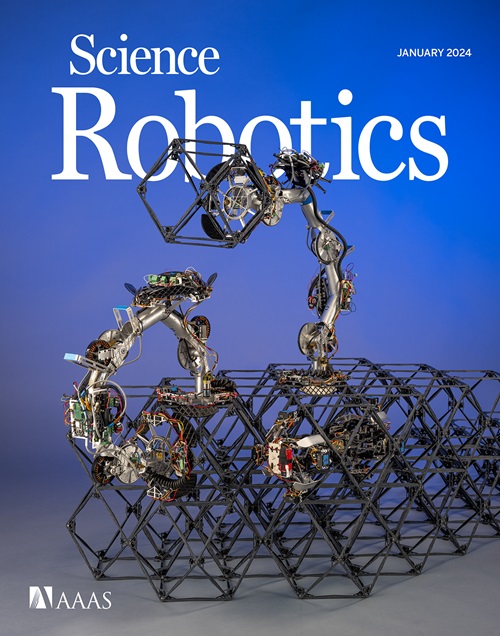在假手的感觉-运动控制中激发脊髓自然反射回路。
IF 26.1
1区 计算机科学
Q1 ROBOTICS
引用次数: 0
摘要
用于假肢控制的感官反馈通常是基于将感官信息编码为特定类型的感官刺激,由使用者解读这些刺激以调整对假肢的控制。然而,在生理条件下,从外周神经接收到的传入反馈不仅会被有意识地处理,还会调节脊髓反射回路,从而为驱动肌肉的神经信息做出贡献。脊髓通路与感觉-运动整合相关,但通常不用于假肢控制。我们提出了一种方法,通过肌腱振动与肌肉活动形成闭环来调节脊柱回路的兴奋性,从而改善假肢控制的感觉-运动整合。我们测量了健康参与者和截肢者在不同运动任务中的肌肉信号,并通过振动连接肌肉的肌腱来调节运动神经元的兴奋性,从而形成闭环。因此,假肢的控制信号是自主控制和肌腱振动引起的额外脊髓反射输入的结合。结果表明,闭环肌腱振动能够调节神经对肌肉的驱动。当使用闭环肌腱振动时,参与者在使用肌肉激活的界面中可以获得与不使用刺激类似或更好的控制性能。刺激甚至可以改善截肢者的假肢抓握能力。总之,我们的研究结果表明,闭环肌腱振动可以将脊髓反射通路整合到肌肉控制系统中,为将自然反馈回路纳入假肢控制提供了可能。本文章由计算机程序翻译,如有差异,请以英文原文为准。
Excitation of natural spinal reflex loops in the sensory-motor control of hand prostheses
Sensory feedback for prosthesis control is typically based on encoding sensory information in specific types of sensory stimuli that the users interpret to adjust the control of the prosthesis. However, in physiological conditions, the afferent feedback received from peripheral nerves is not only processed consciously but also modulates spinal reflex loops that contribute to the neural information driving muscles. Spinal pathways are relevant for sensory-motor integration, but they are commonly not leveraged for prosthesis control. We propose an approach to improve sensory-motor integration for prosthesis control based on modulating the excitability of spinal circuits through the vibration of tendons in a closed loop with muscle activity. We measured muscle signals in healthy participants and amputees during different motor tasks, and we closed the loop by applying vibration on tendons connected to the muscles, which modulated the excitability of motor neurons. The control signals to the prosthesis were thus the combination of voluntary control and additional spinal reflex inputs induced by tendon vibration. Results showed that closed-loop tendon vibration was able to modulate the neural drive to the muscles. When closed-loop tendon vibration was used, participants could achieve similar or better control performance in interfaces using muscle activation than without stimulation. Stimulation could even improve prosthetic grasping in amputees. Overall, our results indicate that closed-loop tendon vibration can integrate spinal reflex pathways in the myocontrol system and open the possibility of incorporating natural feedback loops in prosthesis control.
求助全文
通过发布文献求助,成功后即可免费获取论文全文。
去求助
来源期刊

Science Robotics
Mathematics-Control and Optimization
CiteScore
30.60
自引率
2.80%
发文量
83
期刊介绍:
Science Robotics publishes original, peer-reviewed, science- or engineering-based research articles that advance the field of robotics. The journal also features editor-commissioned Reviews. An international team of academic editors holds Science Robotics articles to the same high-quality standard that is the hallmark of the Science family of journals.
Sub-topics include: actuators, advanced materials, artificial Intelligence, autonomous vehicles, bio-inspired design, exoskeletons, fabrication, field robotics, human-robot interaction, humanoids, industrial robotics, kinematics, machine learning, material science, medical technology, motion planning and control, micro- and nano-robotics, multi-robot control, sensors, service robotics, social and ethical issues, soft robotics, and space, planetary and undersea exploration.
 求助内容:
求助内容: 应助结果提醒方式:
应助结果提醒方式:


